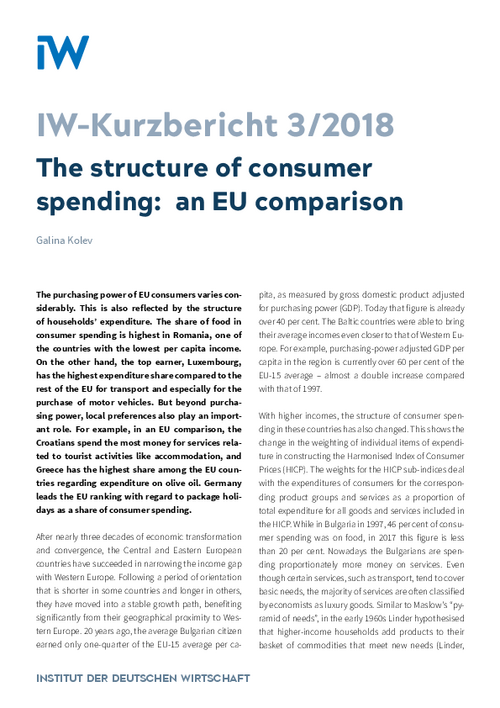The purchasing power of EU consumers varies considerably. This is also reflected by the structure of households’ expenditure. The share of food in consumer spending is highest in Romania, one of the countries with the lowest per capita income. On the other hand, the top earner, Luxembourg, has the highest expenditure share compared to the rest of the EU for transport and especially for the purchase of motor vehicles.

An EU comparison: The structure of consumer spending
IW-Kurzbericht

The purchasing power of EU consumers varies considerably. This is also reflected by the structure of households’ expenditure. The share of food in consumer spending is highest in Romania, one of the countries with the lowest per capita income. On the other hand, the top earner, Luxembourg, has the highest expenditure share compared to the rest of the EU for transport and especially for the purchase of motor vehicles.
But beyond purchasing power, local preferences also play an important role. For example, in an EU comparison, the Croatians spend the most money for services related to tourist activities like accommodation, and Greece has the highest share among the EU countries regarding expenditure on olive oil. Germany leads the EU ranking with regard to package holidays as a share of consumer spending.
After nearly three decades of economic transformation and convergence, the Central and Eastern European countries have succeeded in narrowing the income gap with Western Europe. Following a period of orientation that is shorter in some countries and longer in others, they have moved into a stable growth path, benefiting significantly from their geographical proximity to Western Europe. 20 years ago, the average Bulgarian citizen earned only one-quarter of the EU-15 average per capita, as measured by gross domestic product adjusted for purchasing power (GDP). Today that figure is already over 40 per cent. The Baltic countries were able to bring their average incomes even closer to that of Western Europe. For example, purchasing-power adjusted GDP per capita in the region is currently over 60 per cent of the EU-15 average – almost a double increase compared with that of 1997.
With higher incomes, the structure of consumer spending in these countries has also changed. This shows the change in the weighting of individual items of expenditure in constructing the Harmonised Index of Consumer Prices (HICP). The weights for the HICP sub-indices deal with the expenditures of consumers for the corresponding product groups and services as a proportion of total expenditure for all goods and services included in the HICP. While in Bulgaria in 1997, 46 per cent of consumer spending was on food, in 2017 this figure is less than 20 per cent. Nowadays the Bulgarians are spending proportionately more money on services. Even though certain services, such as transport, tend to cover basic needs, the majority of services are often classified by economists as luxury goods. Similar to Maslow's “pyramid of needs”, in the early 1960s Linder hypothesised that higher-income households add products to their basket of commodities that meet new needs (Linder, 1961). Even though these do not necessarily constitute only services, the growth in the share of services in consumer spending provides clues to the ongoing shift. The share of services in total expenditure in Bulgaria in 1997 was only 9 per cent. Currently, almost one-third of household spending in Bulgaria is on services. One reason is certainly the convergence-related increase in prices for services that are labour-intensive in production and therefore very sensitive to rising wages, as compared to commodities that meet basic needs and are produced with a greater amount of physical capital (see Bhagwati, 1984). Nevertheless, the increasing share of services in total expenditure is not to be attributed solely to the price effect. Rather, the shift in demand is also a very important explanation. According to the Linder hypothesis, services have an income elasticity greater than one, so that rapid economic growth in the context of the convergence process leads to a shift in the demand structure of private households towards more services or other luxury goods relative to other goods (see Bergstrand, 1991).
The hypothesis that the differences in income account for an important part of the different distribution of consumer spending is also reflected in the cross-sectional comparison of the weights in the HICP for 2017 (Figure):
- With just under 37 per cent, the share of expenditure on food, beverages and tobacco products is highest in Romania, the country with the second-lowest per capita income adjusted for purchasing power. By contrast, in the United Kingdom this category accounts for only around 14 per cent of consumer spending.
- Compared to the rest of the EU, the British spend the most money on (mostly) luxury goods and services in the area of recreation and culture. These account for about 15 per cent of their expenditure. At the bottom of the category is still crisis-ridden Greece, where only 4 per cent of consumer spending is on goods and services in the area of recreation and culture.
- As regards expenditure on restaurants and hotels is not included in this figure. Here, Greece ranks third after Ireland and Cyprus in the EU comparison, despite the ongoing economic crisis. Nearly 18 per cent of Greek household expenditure falls into this category. In Germany, the share spent on restaurants and hotels is just under 6 per cent, below the EU average of 9.5 per cent.
- Germany leads the ranking for expenditure on package holidays. On average, EU citizens spend only 1.7 per cent of their budget on package holidays. In Germany, however, this figure is 3.8 per cent. Especially the demand for international package holidays in Germany appears to be above average.
- The largest part of the Germans’ budget, however, goes to housing. In Germany, over one-quarter of the expenditure covered by the HICP is attributable to rentals, ancillary costs, household goods such as furniture, and maintenance. Thus, Germany stands in the first place in the EU comparison. Whether this is due to the low percentage of home ownership, cannot be directly determined from the data. Still, rent does not seem to be the decisive factor: the subcategory of actual rentals accounts for only 10 per cent of recorded expenditure. A rental equivalent for owner-occupied residentail property is not included here, unlike the national consumer price index of the Federal Statistical Office of Germany. As a result, actual housing costs are likely to be even higher than suggested by the index.
Even though a substantial proportion of the structure of spending of EU consumers can be explained by income differences, local preferences also play an important role due to cultural and historical developments. It comes as little surprise that the category of pizza and quiche accounts for the largest share of private household expenditure in Italy; in Greece, there is high demand for olive oil. Italian households are also leaders in terms of the share of clothing in total expenditure.
In many of the categories, however, an explanation regarding shares of expenditure is not possible due to either income differences or cultural differences. Thus, it remains doubtful whether different preferences explain the fact that the share of footwear purchases in total expenditure is highest in Portugal and lowest in Finland. It is likewise difficult to explain the ranking for spending on furnishings and household equipment – in this category Malta is in first place, at nearly 2 per cent. In Greece, the share of expenditure on furnishings and household equipment is lowest at 0.4 per cent.

Galina Kolev: The structure of consumer spending – An EU comparison
IW-Kurzbericht

More on the topic

Strengthened competition in payment services
Starting on January 13, 2018, the Second Payment Services Directive (PSD2) will apply in the European Union. Among other things, the Directive’s aim is to adapt regulation to the innovations in payment services and to promote the Single Market for non-cash ...
IW
Safe Asset Shortage by Regulation
Banks have changed their asset allocation. While the number of loans to non-financial corporations on their balance sheets is slowly growing after a period of deleveraging, banks’ demand for Euro-area sovereign bonds is still accelerating. The high demand for ...
IW